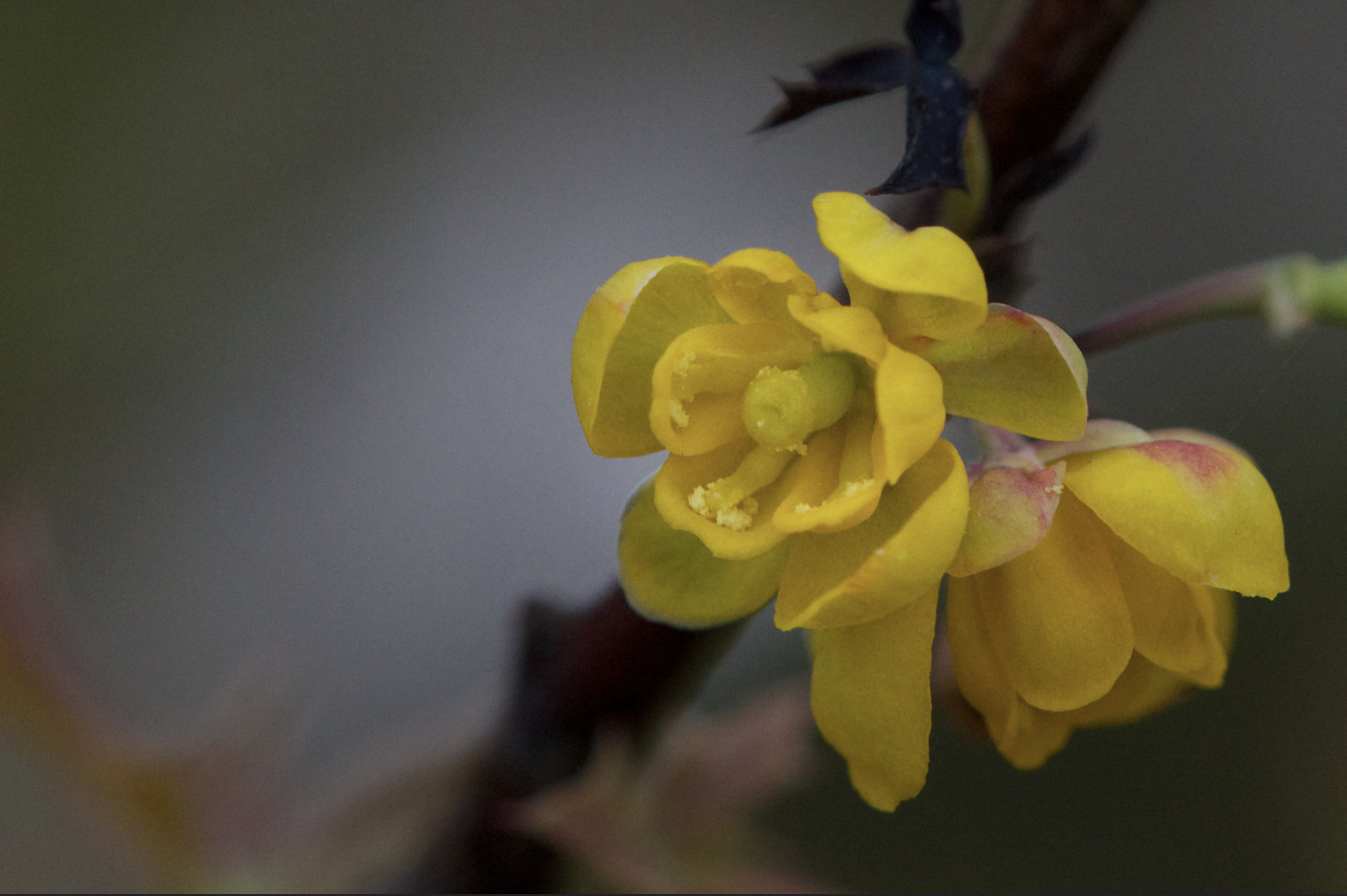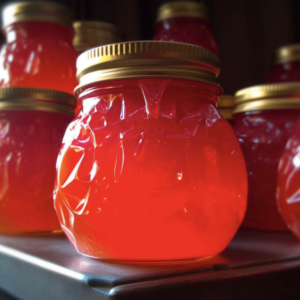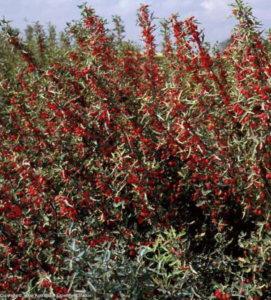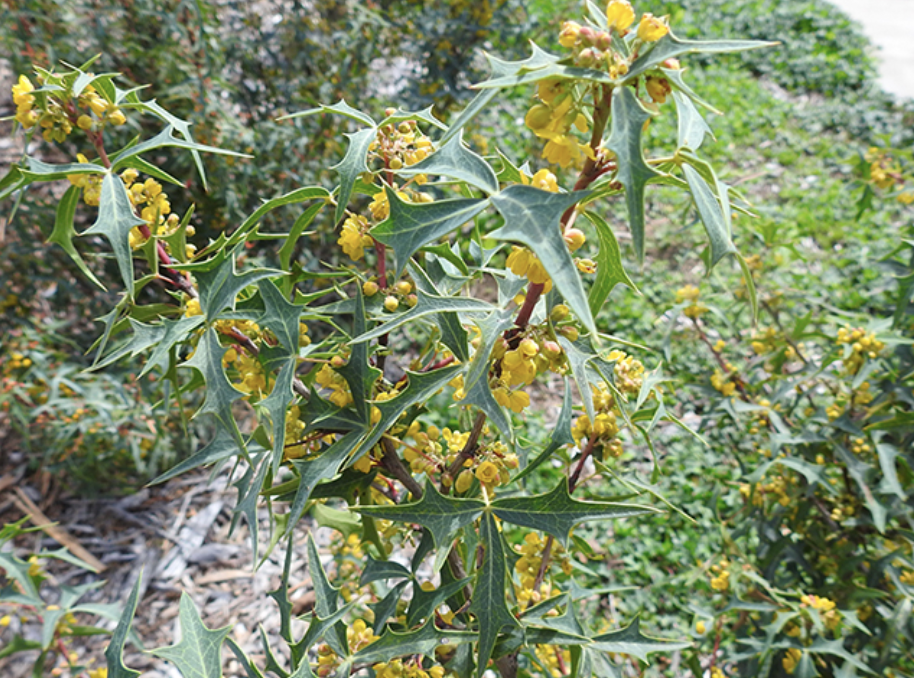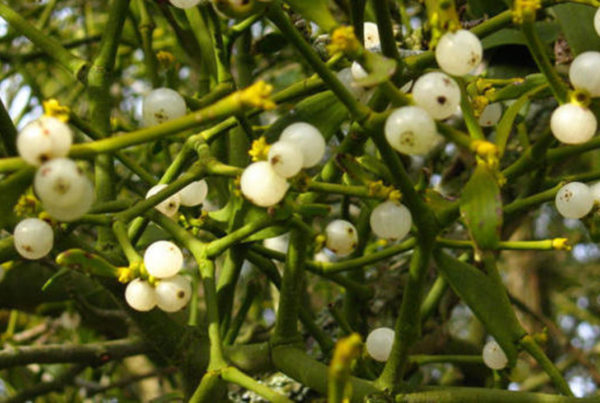Currently in bloom across Texas lies a botanical treasure: Mahonia trifoliolata, formerly known as Berberis trifoliolata until a name change in 2016 to reflect ongoing botanical research and classification efforts. This plant is native to southwestern North America and is a testament to the resilient and diverse flora of our great state.
A Spring Spectacle
Mahonia trifoliolata, widely recognized as “agarita” or agarito,” showcases the resilient beauty and versatility of Texas’s indigenous plants. Its evergreen, spiky leaves and bright yellow flower clusters that emerge in early spring bring a unique charm to the Texas scenery, while also perfuming the air with their delightful scent. This early bloomer plays a vital role in supporting pollinators, serving as a key element in maintaining a balanced ecosystem. The shrub’s tart, ruby-red berries, which are similar in taste to cranberries, are a prized food source for both wildlife and people.
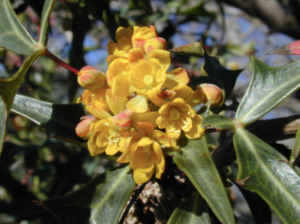
An interesting note on its name: “Agarita” derives from the Spanish verb “agarrar,” meaning “to grab,” with the diminutive suffix “-ita” often added to indicate something small. Thus, “agarita” translates to “grabs a little.” This name likely refers to the plant’s somewhat scratchy nature, though it lacks significant spines.
Habitat and Distribution in Texas
Agarita thrives in the arid, rocky terrain of Texas, particularly in the Hill Country and Edwards Plateau regions. Here, amid the rugged limestone hills and expansive grasslands, agarita finds its niche, flourishing in well-drained soils and sun-drenched slopes. Its ability to withstand drought and thrive in challenging conditions makes it a beloved fixture in the Texas landscape.
The Benefits of Mahonia trifoliolata (Agarita) in Texas
Agarita, is a valuable addition to the Texas landscape, offering benefits to humans, wildlife, and the ecosystem.
For Humans:
Culinary Uses: Agarita berries are used in jellies, wines, offering a unique taste of Texas.
Historical Uses: The roots provided a yellow dye for early pioneers.
For Wildlife:
Food Source: The berries nourish songbirds, quail, and small mammals, while its foliage offers shelter and nesting sites.
Pollinator Support: Early spring flowers are crucial for pollinators.
Ecological and Landscaping Benefits:
Wildlife Habitat: Provides excellent cover for wildlife, supporting biodiversity.
Deer Resistant: Its high deer resistance makes it ideal for areas prone to deer browsing.
Additional Attributes:
Honey Source: A valuable source for honey production.
Fragrant Flowers and Interesting Foliage: Adds sensory appeal and visual interest to landscapes.
Incorporating agarita into your property supports a vibrant, wildlife-friendly, and resilient Texas landscape.
Agarita’s Texas Tradition: From Healing to Dining 
Beyond its ecological importance, agarita holds a special place in Texas’s cultural heritage. For generations, Texans have cherished agarita for its culinary versatility and medicinal properties. The tart berries, once harvested and processed, can be transformed into jams, jellies, and syrups, adding a unique flavor to traditional Texan cuisine. Additionally, agarita has been used in herbal medicine for its purported health benefits, ranging from immune support to digestive aid.
Learn how to make delicious Agarita Jelly with this easy recipe! Made from the juice of the agarita plant, this unique jelly has a bright and tangy flavor that’s perfect for spreading on toast or using as a glaze for meats. With just three simple ingredients, this recipe is easy to make and doesn’t require any fancy equipment or techniques. Click here to visit the full recipe!
Guarding Agarita
Agarita, despite its hardiness, is vulnerable to challenges such as habitat destruction, excessive harvesting, and competition from invasive species. The stewardship of Texas landowners is vital in safeguarding the future of agarita. Protecting its natural environment and adopting ethical harvesting methods are key to its preservation. Emphasizing eco-friendly land management and spreading the word about the value of indigenous plants are steps toward ensuring agarita’s prosperity for future generations.
Incorporating agarita into your environmental and landscaping efforts not only enhances your property’s beauty and biodiversity but also contributes significantly to the conservation of this distinctive Texas shrub.
 Quick Plant Facts: Mahonia trifoliolata
Quick Plant Facts: Mahonia trifoliolata
Common Names: Agarita, Agarito, Algerita, Laredo Mahonia, Trifoliate Barberry, Wild Currant
Former Name: Berberis trifoliolata (changed in 2016)
Family: Berberidaceae (Barberry Family)
Height: Can reach up to 10 feet in favorable conditions, typically 3-6 feet
Leaves: Gray-green to blue-gray, trifoliate, holly-like with sharp spines
Flowers: Vibrant yellow, fragrant blooms in early spring (February to April)
Berries: Edible red berries, ripe from May to July
Habitat: Native to Texas, New Mexico, Arizona, and northern Mexico. Thrives in hills, open woods, rocky slopes, and cliffs.
Soil: Prefers rocky, limestone soil but is adaptable
Water Use: Low, drought-tolerant once established
Sunlight: Full sun to part shade
Wildlife Benefits: Provides food for pollinators and birds; offers shelter and nesting sites for various wildlife
Human Use: Berries used in jellies and wines; roots historically used for yellow dye
Landscape Use: Ideal for sustainable landscaping, wildlife gardens, and as a natural cover for wildlife
Drawing inspiration from sources like the Lady Bird Johnson Wildflower Center and the Texas A&M AgriLife Extension, this blog post celebrates the beauty and significance of Mahonia trifoliolata among Texas’ native flora. Featured image courtesy of Jim McCulloch.




